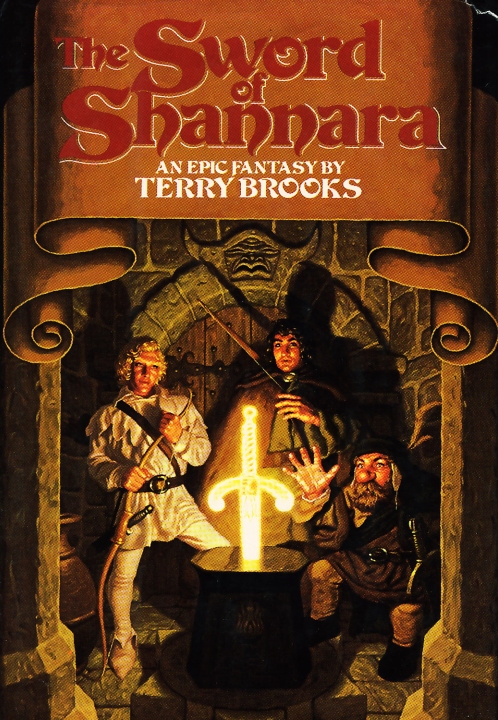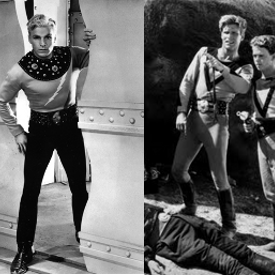In recent months, I’ve been treating myself to a re-read of those novels and series that have accumulated on my bookshelves over decades spent enjoying the Fantasy and Science Fiction genres. In particular, I started Running With The Demon, by Terry Brooks, and wasn’t halfway through that story when I was reminded of something. Something that – for me – is really important, and goes a hell of a long way to explaining the profound satisfaction I get from reading a good book.
What was it?
Well, I’m going to have to go around the houses a little to clarify what I mean. But bear with me, because doing so will help you understand the immense satisfaction I get from the slow burn.
Now, you’ll probably have noticed references in my previous items about my being a fan of the slow burn. You know, those adventures that don’t just extend the story arc over one book – or even a single series – come to that. Oh no, I’m something of an advocate for the fuse that gradually fizzles away in the background, building and building, until the epic conclusion generations of books later. Think Raymond E. Feist, Brandon Sanderson, and Stephen R. Donaldson, to name a few.
I absolutely love those authors who take the time to develop something special. Something that allows that theme or the subtext of what they’ve created to sink into the threads of their introduction, only to see it develop and mature through progressive sequels . . . and in some cases, prequels.
And it all began, quite by chance, way back in 1977 when I made one of my many visits to Hudson Bookstore, in Birmingham, UK – a place I’ve also mentioned before – and came across a copy of this:

I’m sure many of you will recognize this first edition cover of an epic that went on to set the bar for many a fantasy adventure that followed.
The thing is, unbeknown to me at the time, this story also introduced me to the concept of the slow burn. How so?
Well, let me explain.
Like many readers who find a new author they enjoy, I went back to the store as soon as I finished the book, and looked for other stories by the same author. The thing is, I was forced to wait until 1982 before The Elfstones of Shannara finally hit the shops.
Other books followed: Wishsong of Shannara; The Scions of Shannara; The Druid of Shannara; Elf Queen of Shannara; The Talisman of Shannara; First King of Shannara, etc, all expanding the same theme regarding the magic wielded by a particular bloodline in a far-flung distant future. . .
Hang on . . . Did I say distant future?
I sure did! And that was the thing. If you paid attention to certain details that were sprinkled throughout the original stories, you began to appreciate that these fantastical adventures were in fact, set on the Earth, at a time and in circumstances very different to what we see around us now. (Fans of the stories will know what I mean).
I remember thinking at the time. How did Terry Brooks come up with that concept, and indeed, how did society ever get to become the way it was described in the Shannara books?
Well, I had to wait almost twenty years before that question began to be answered, and only then when Terry Brooks finally released Running With The Demon, way back in 1997.

Now, I was aware Terry Brooks wrote other series. In 1987, for example, he released Magic Kingdom For Sale – Sold. Something I thought that was rather entertaining, and possessed of an entirely different flavor to his Shannara novels. And, I naturally assumed that would also be the case with Running With The Demon, for it was set in the here and now, and portrayed the struggle between good and evil for the dominion of mankind’s soul.
‘Good’ was represented by the Lady and her servants of the Word, Sylvans, Tatterdemalions and other supernatural creatures who tended the forests and other aspects of the Earth, along with her human representatives – otherwise known as Knights of the Word and bearers of the black staff of power that helped them combat evil – the Void, and it’s servants, Demons, who were forever at large, subverting the will of men to self-destructive and wicked causes that, if left unchecked, would see society as we know it collapse, and through that, the Earth itself brought to ruin.
I remember thinking at the time how original that concept was, as people would be able to relate what they were reading to what was actually unfolding all around us in the news every day.
We were introduced to characters like Nest Freemark, O’olish Amaneh, the Gypsy Morph, the King of the Silver River, and Findo Gask. Heroes, heroines and villains who would draw you into an intricate world of diabolical deeds and skullduggery of subtle, yet ambitious scope.
However, little did I know at the time that this new series was, in fact, the seed of something special. Something that would grow and mature and develop into a direct link between the here and now, and that far future world I mentioned, first discovered in The Sword of Shannara.
And THAT, my friends, takes some master class planning and execution. Because it’s one thing to set a story in the here and now. We can relate to it. Grasp what’s going on. See common threads in the news bulletins and events from around the world that could so easily tie into the theme of the book. But, to then stretch that into a world of elves and trolls and demons? Ah, that was most excellent, as the gradual transition gave rise to a series of mini-epics in themselves, all adding to the building blocks that became the world of Shannara, or, as it is ‘then’ called, The Four Lands.

And just to help you get a grasp what I’m going on about, here’s a rough timescale:
The Word and the Void novels take place in the present day.
The Genesis of Shannara series:
(It is by this point that the Demons of the Void are openly trying to bring about a world-wide apocalypse. This causes the creatures of Faerie to emerge from hiding, including the Elves and their Elfstones).
This series is pivotal, as it is set about 50 years after that apocalypse, and the demons are intent on sending what remains of present-day life tumbling. (Radioactive wastes; crumbling cities; poisoned water; infertile land; pandemics that either kill people outright, or, in conjunction with the other effects of a biological-chemical-nuclear war, mutate the survivors into something else; a total loss of ‘civilization’ as society is reduced into scrabbling militias).
Think about 2100 AD on our calendar. Fortunately, the series ends with what’s left of the human and Faerie population eventually finding a refuge to wait out the total collapse of the world.
Legends of Shannara picks up about 500 years later, when the refugees – now a settled society in themselves – emerge into the world at large. The transition into what becomes The Four Lands is still ongoing, and the Druids haven’t yet emerged, but you can begin guessing at where they might come from as the seeds for their appearance are scattered quite nicely . . . if you know how to look.
Obviously, you then get to Shannara Series itself: First King of Shannara; The Sword of Shannara; The Elfstones of Shannara; The Wishsong of Shannara, set a long, long time after the Four Lands are established. (About two thousand years following the Great War).
By this time, the planet’s geography has been altered, and whatever technology exists is hidden away in nuclear shelters (later hinted at in the Jerle Shannara series – which takes place about 450 years after The Sword of Shannara – when Antrax, one of the few remaining Druids rediscovers a bunker containing a bunch of ‘old world’ technology left over from the war, including what is obvious an AI entity).
The demons of the void still exist, of course, albeit they have also evolved and are still intent on despicable goals. (I have to say, I thoroughly enjoyed that transition). And the survivors of the old world now live in their own communities: the North being inhabited by trolls; the east by dwarves and gnomes; the south by men, and the west by elves.

What I particularly liked about this huge, multi-series extravaganza is that you can almost envisage where it is. Remember, the majority of the earlier novels take place in the Pacific Northwest and Canada (this is made clear in the Genesis series where the refugees flee to a dam, situated on the Columbia River and seek shelter somewhere in the Columbia River basin) which, as you know, is vast, and incorporates a number of Native American reservations – which are also alluded to in the books; a variety of mountain chains, forests and freshwater courses.
Well, you can almost ‘see’ that in the map, and picture how the upheaval morphed into the world of Shannara.
Fans of the books will also remember the volcanic region of Morrowindl, found west of the Four Lands, which Terry Books admitted was based on Hawaii. The Pacific Ocean is still there, though it’s now called the Blue Divide, and far, far on the other side of the Blue Divide is the land of Parkasia – most certainly modern-day Asia.
Now, I don’t know about you, but I really appreciate hooks and links like this, as it helps to ‘ground’ make-believe in reality. Yes, we’re talking epic fantasy here. Magic and elves, trolls and demons, men and monsters. . .
But the mere fact that the roots of the entire story were spawned in the here and now? On reality. On ‘what if’ radioactive/chemical/biological mutations did spin our DNA along this particular course, or that? You see? It adds that something special to the overall story arc. Something that helps the fuse I mentioned at the beginning, burn more assuredly in our imaginations. And it’s been burning now for almost 50 years. Fifty years! That’s one hell of an achievement.
But of course, Terry Brooks isn’t the only master of the slow burn of which I’m a fan.
Next time out, I shall be discussing one of my all-time favorite authors. Raymond E. Feist.
But until then, why not try this epic series out?










